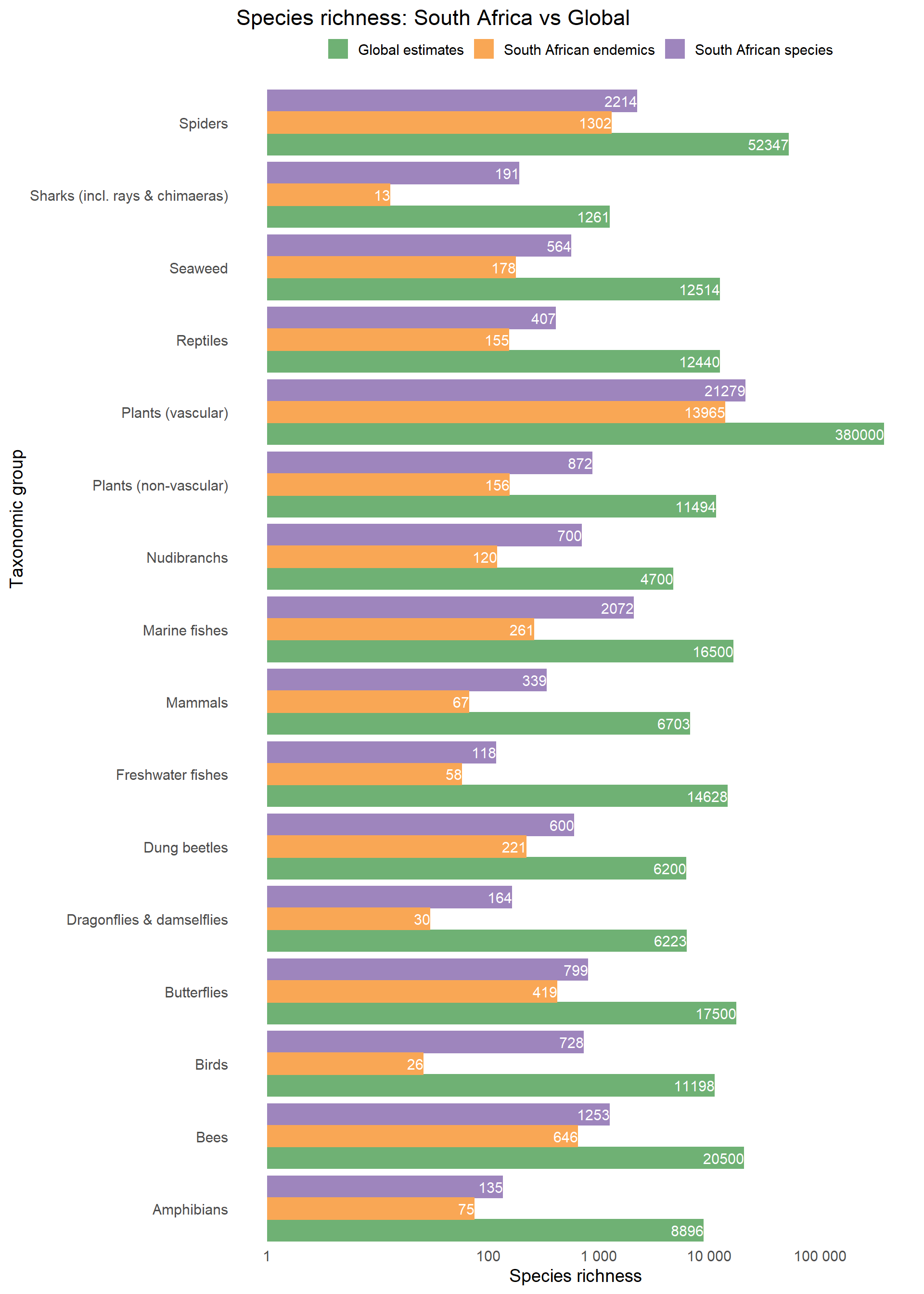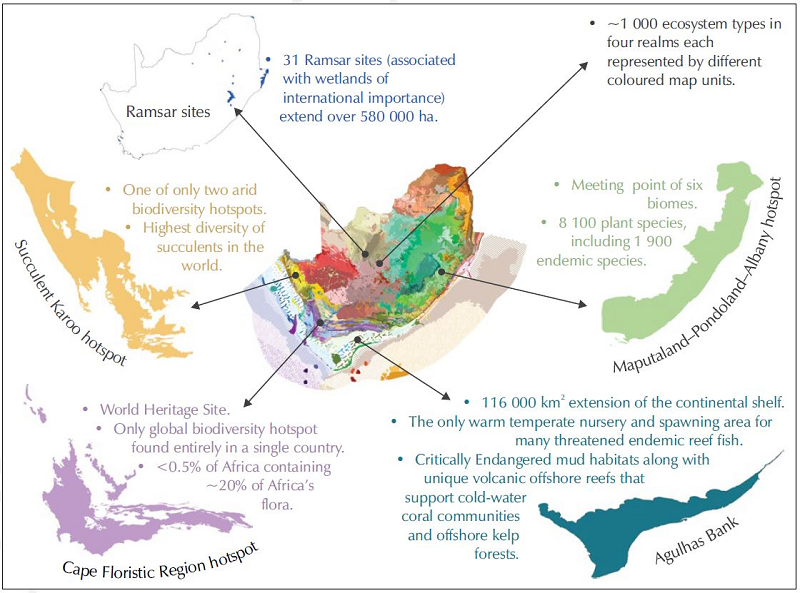
Summary
South Africa has exceptional biodiversity that is globally recognised, characterised by high species richness, high rates of endemism and a wide variety of ecosystem types. Although among the smaller of the world’s 17 megadiverse countries, which together contain more than two-thirds of the world’s biodiversity, South Africa ranks in the global top ten of countries in terms of plant species richness and third for marine species endemism. The country holds three of the world’s 36 recognised biodiversity hotspots, 31 Ramsar sites (wetlands of international importance, including the subantarctic Prince Edward Islands) and the Agulhas Bank that is an equivalently unique marine ecosystem (Figure 1). Applying the international standard, South Africa has identified 263 terrestrial Key Biodiversity Areas (KBAs), which are sites of global biodiversity significance. This network of KBAs is expected to expand over time as the marine realm is assessed.

Ecosystem facts
South Africa has a wide range of bioclimatic, oceanographic, geological and topographical settings. Together, these support high ecosystem diversity and endemism. Almost 1 000 distinct ecosystem types have been described and for the purposes of the NBA these are grouped into four realms: terrestrial, freshwater (rivers and inland wetlands), estuarine and marine. The cross-realm coastal zone is made up of selected terrestrial and marine ecosystems and all estuaries, and the Subantarctic is made up of the marine and terrestrial ecosystems of the Prince Edward Islands, 1 700 km south of mainland South Africa.
Terrestrial realm: Nine biomes and 463 ecosystem types, approximately 80% of which are endemic.
Freshwater realm: Highly variable rainfall supports diverse freshwater ecosystems; wetlands are classified into 82 distinct types, and rivers are classified into 222 distinct types.
Marine realm: Exceptional marine biodiversity, represented by 163 distinct ecosystem types.
Estuarine realm: South Africa’s 290 estuaries and 42 micro-estuaries are classified into 22 estuarine ecosystem types and three micro-estuary types.
Cross-realm coastal zone: An ecological definition of the coast is used for biodiversity assessments. It comprises 190 ecosystem types from the terrestrial (83 types), estuarine (22 types) and marine (85 types) ecosystem maps to form a cross-realm coastal zone.
South Africa’s subantarctic territory consists of Prince Edward Island, Marion Island and surrounding maritime domain. There are five terrestrial and 29 marine ecosystem types.
Species facts

South Africa is rich in species (Figure 2) and is home to an estimated 67 000 animal species, although many invertebrates remain undescribed or undiscovered. The 2025 South African National Plant Checklist records 23 514 taxa and 21 539 species, of which 20 204 are indigenous. Remarkably, 60.5% of these indigenous species are endemic to the country.
Current estimates indicate that South Africa harbours approximately 8% of the world’s non-vascular and 6% vascular plant species; and 10% of the world’s dung beetle, 7% of bird, 6% of bee, 5% of mammal, 3% of reptile, 2% of amphibian and 1% of freshwater fish species. In the marine realm, South Africa supports 15% of the world’s shark, ray and chimaera species, 15% of nudibranch, 13% of marine (bony) fish, and 5% of seaweed species (including brown, green and red algae). Several terrestrial invertebrate groups have high richness relative to global statistics, with South Africa hosting nearly 5% of the world’s butterfly, 4% of spider, and 3% of dragonfly and damselfly species.
Two-thirds of South Africa’s plant species are endemic, and its cycads represent 10% of the global species count with 92% endemism. Around half of the South African species of amphibians, butterflies, bees, spiders and freshwater fishes are endemic, as are nearly 40% of dung beetle and reptile species. Approximately 30% of seaweed species and 40% of South Africa’s estimated 10 000 marine animal species are endemic, the vast majority being invertebrates.
Microorganisms (e.g., bacteria, protozoa, fungi, viruses), an often-overlooked and largely unassessed group, are essential for healthy functioning of natural and agricultural systems in both terrestrial and aquatic environments. Given the country’s immense diversity of floral and faunal species, and that each species has its own array of microbial species associated with it, it is likely that these are also diverse. For example, it has been estimated that each unique vascular plant species in South Africa is associated with at least seven unique fungal species, implying more than 171 000 fungi species (an underestimate, as fungi associated with invertebrates are not included).
Find out more in this downloadable biodiversity profile Factsheet.
Recommended citation
Dayaram, A., Van der Colff, D., Mtshali, H., Klopper, R., Le Roux, M., Poole, C., Dlamini, T., Sink, K., Currie, J., Skowno, A., Jones, G., Khatieb, S., Mogajane, K., Hamer, M., Truter, M., Jacobs, A., Venter, F., & Seymour, C. 2025. South Africa’s biodiversity profile. National Biodiversity Assessment 2025. South African National Biodiversity Institute. http://nba.sanbi.org.za/.
Sources
Global richness
- American Society of Mammalogists, 2025. Mammal Diversity Database (Version 2.3) [Data set]. Available at: https://www.mammaldiversity.org/ [Accessed 01 August 2025].
- Bánki, O., Roskov, Y., Döring, M., Ower, G., Hernández Robles, D. R., Plata Corredor, C. A., Stjernegaard Jeppesen, T., Örn, A., Pape, T., Hobern, D., Garnett, S., Little, H., DeWalt, R. E., Miller, J., Orrell, T., Aalbu, R., Abbott, J., Aedo, C., Aescht, E., et al., 2025. Catalogue of Life (Version 2025-08-20). Catalogue of Life Foundation. Available at: https://www.catalogueoflife.org/ [Accessed 01 August 2025].
- BirdLife International, 2025. BirdLife taxonomy. Available at: https://datazone.birdlife.org/about-our-science/taxonomy [Accessed 01 August 2025]
- Cabral, H., Díaz de Astarloa, J.M., Petrik, C.M., Costa, M.J. & Marques, J.F., 2025. The diversity and life-history patterns of marine fishes. In: H. Cabral, M. Lepage, J. Lobry & O. Le Pape, eds. Ecology of Marine Fish. Academic Press, pp.25–43. doi:10.1016/B978-0-323-99036-3.00011-8
- Calonje, M., Stevenson, D.W. & Osborne, R., 2025. The World List of Cycads (Version 2025.09.04-r1). Montgomery Botanical Center. Available at: https://cycadlist.org/ [Accessed 01 August 2025]
- CERN, n.d. Zenodo. Available at: https://zenodo.org/[Accessed 01 August 2025].
- Ebert, D.A., Wintner, S.P. & Kyne, P.M. (2021). An annotated checklist of the chondrichthyans of South Africa. Zootaxa, 4947 (1), 1–127. https://doi.org/10.11646/zootaxa.4947.1.1
- Frost, D. R. (Ed.). (2025). Amphibian species of the world: An online reference (Version 6.0). American Museum of Natural History. Retrieved August 01, 2025, from https://amphibiansoftheworld.amnh.org/
- Sayer, C.A., Fernando, E., Jimenez, R.R. et al. One-quarter of freshwater fauna threatened with extinction. Nature 638, 138–145 (2025). https://doi.org/10.1038/s41586-024-08375-z
- Smithsonian Institution, n.d. Butterflies. Available at: https://www.si.edu/spotlight/buginfo/butterfly [Accessed 01 August 2025].
- Uetz, P., Freed, P., Aguilar, R., Reyes, F., Kudera, J. & Hošek, J. (eds.), 2025. The Reptile Database. Available at: https://www.reptile-database.org/ [Accessed 01 August 2025].
- World Flora Online, 2025. World Flora Online plant list. Available at: https://wfoplantlist.org/ [Accessed 01 August 2025].
- WoRMS Editorial Board, 2025. World Register of Marine Species. Available at: http://www.marinespecies.org [Accessed 01 August 2025].
South African species richness
- Foord, S. H., Dippenaar-Schoeman, A. S., Haddad, C. R., Lyle, R., Lotz, L. N., Sethusa, T., & Raimondo, D. (2020). The South African National Red List of spiders: patterns, threats, and conservation. Journal of Arachnology, 48(2), 110–118. https://doi.org/10.1636/0161-8202-48.2.110
- Klopper, R.R. & Winter, P.J.D. 2025. South African National Plant Checklist statistics, version 2025.1. South African National Biodiversity Institute, Pretoria. Available at: https://hdl.handle.net/20.500.12143/6880.3 [Accessed 25 June 2025].
- Le Roux, M.M. & Klopper, R.R., 2025. Taking stock of South Africa’s flora. South African Journal of Botany, 184, pp.571–579. doi:10.1016/j.sajb.2025.05.049
- Melin, A., Beale, C.M., Manning, J.C. & Colville, J.F. (2024) Fine-scale bee species distribution models: Hotspots of richness and endemism in South Africa with species-area comparisons. Insect Conservation and Diversity, 17(3), 474–487. Available from: https://doi.org/10.1111/icad.12715
- South African National Biodiversity Institute. 2025. Botanical Database of Southern Africa (BODATSA) [dataset]. https://posa.sanbi.org/
- Tolley, K.A., Weeber, J., Maritz, B., Verburgt, L., Bates, M.F., Conradie, W., Hofmeyr, M.D., Turner, A.A., da Silva, J.M. & Alexander, G.J., 2019. No safe haven: Protection levels show imperilled South African reptiles not sufficiently safe-guarded despite low average extinction risk. Biological Conservation, 233, pp.61–72. doi:10.1016/j.biocon.2019.02.006
- University of Cape Town, Seaweed Research Group, n.d. South African Seaweeds: Systematic index. Available at: http://southafrseaweeds.uct.ac.za/systematicindex.php [Accessed 01 August 2025].